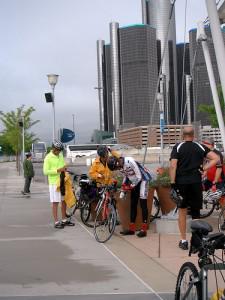 Last weekend, over 4,000 people took to the streets of Detroit not in cars, but on bikes. The 11th annual Tour de Troit raised awareness of biking as a viable means of transportation in the Motor City and raised funds for the growing greenway system in southeast Michigan. Despite the much chronicled decline of Detroit, maybe biking and other alternative modes of transportation offer opportunities for a “Post”-Motor City.
Last weekend, over 4,000 people took to the streets of Detroit not in cars, but on bikes. The 11th annual Tour de Troit raised awareness of biking as a viable means of transportation in the Motor City and raised funds for the growing greenway system in southeast Michigan. Despite the much chronicled decline of Detroit, maybe biking and other alternative modes of transportation offer opportunities for a “Post”-Motor City.
Detroit’s Non-Motorized Urban Transportation Master (NMUTM) Plan recognizes the numerous strengths that already exist in the city and outlines how new connections could improve residents’ quality of life. The challenge for the city is leveraging the NMUTM Plan to connect Detroit’s myriad resources, including the numerous cultural and economic anchors and institutions, Wayne State University, various hospitals, Belle Isle, downtown’s Renaissance Center, and the Detroit Institute of Art among others.
One opportunity unique to Detroit is that due to the auto-oriented design of the roads and the recent population reduction, there is significant road capacity and streets could be retrofitted to serve all users without reducing their vehicular capacity. Most cities have to make difficult political decisions about trade offs between vehicular and non-motorized access to roads. These changes could be made cheaply and quickly, sometimes with only a can of paint to stripe bike lanes and crosswalks. This opportunity exists now for Detroit and the new bike lanes on 14th Street represent some recent successes.
As much of the city’s population already uses Detroit’s public transportation system, the NMUTM Plan could capitalize on this existing demand. Also, expanding public transportation services and adding other non-motorized transportation connections could improve the city’s public health by increasing physical activity. Finally, the city has an extensive formal park system as well as a growing number of underutilized sites that are acting as open and green spaces, including exciting urban farms. Making biking, walking, and public transit use not only viable, but pleasant, fast, and affordable, could further connect residents to opportunities and water the seeds of revitalization in the “Post”-Motor City.
Image Source

